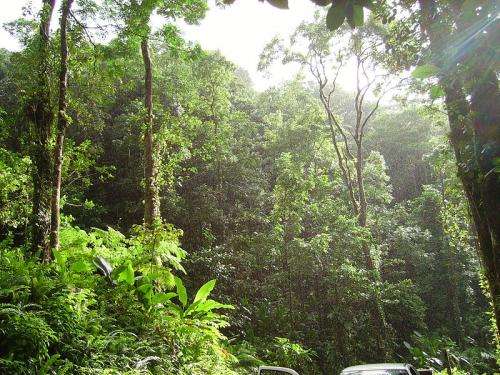September 30, 2016 report
Tropics found to harbor higher degree of intraspecific diversity than other parts of the world

(Phys.org)—A team of researchers with the University of Copenhagen's Natural History Museum of Denmark has found that the degree of intraspecific diversity is higher in the tropics than in other parts of the world. In their paper published in the journal Science, the team describes how they used information from public databases to gather information about diversity around the world and how they used it to map global diversity patterns. Henrique Pereira with the German Centre for Integrative Biodiversity Research offers a broader view on the work done by the team in a Perspectives piece in the same journal issue.
Prior research has shown that there is more plant and animal diversity in the tropics than anywhere else on the planet. In this new effort, the researchers have found the same thing to be true regarding intraspecific (occurring within a species) diversity, at least as it applies to terrestrial mammals and amphibians. They also found that such diversity levels fall near human settlements.
To gain a better perspective regarding differences in intraspecific diversity across the world the researchers queried databases that hold information that publications require to be used before publication of papers regarding animal research. This gave them information regarding 318,000 mitochondrial DNA sequences for animals of the specific two taxa found all over the world. But they soon found that not all could be used for their study because they lacked adequate geographical data—after sifting they were left with 93,000 usable samples which covered approximately 4,700 species. They proceeded to create a virtual grid placed over the planet consisting of ~400-km cells and then assigned each of the samples to a cell.
Once that was complete, they created averages for each cell. Doing so allowed them to measure intraspecific diversity at a more specific level than has ever been done before. It also allowed them to see that intraspecific diversity levels followed closely with diversity levels in general, which meant that the tropics are the most diverse in both categories. It also allowed them to see the impact of human community building—the closer the cells were to such settlements, the lower the diversity levels in them fell.
No one really knows why the tropics are more diverse, but this new research offers support for the theory that suggests that hotter climates cause more genetic mutations in the creatures that live there.
More information: A. Miraldo et al. An Anthropocene map of genetic diversity, Science (2016). DOI: 10.1126/science.aaf4381
Abstract
The Anthropocene is witnessing a loss of biodiversity, with well-documented declines in the diversity of ecosystems and species. For intraspecific genetic diversity, however, we lack even basic knowledge on its global distribution. We georeferenced 92,801 mitochondrial sequences for >4500 species of terrestrial mammals and amphibians, and found that genetic diversity is 27% higher in the tropics than in nontropical regions. Overall, habitats that are more affected by humans hold less genetic diversity than wilder regions, although results for mammals are sensitive to choice of genetic locus. Our study associates geographic coordinates with publicly available genetic sequences at a massive scale, yielding an opportunity to investigate both the drivers of this component of biodiversity and the genetic consequences of the anthropogenic modification of nature.
Journal information: Science
© 2016 Phys.org













.jpg)


